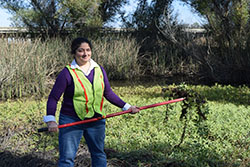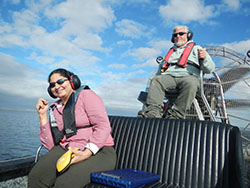Senior Environmental Scientist Shruti Khanna collecting data on an airboat in the Delta.

Khanna raking water primrose, an invasive species of plant found in the Delta.

Khanna (left) with colleague Curtis Hagen (now retired) on a data collection outing in the Delta.
Senior Environmental Scientist Shruti Khanna works for CDFW in the Interagency Ecological Program (IEP), a consortium of state and federal agencies that monitors the health of the Sacramento–San Joaquin River Delta. Khanna works in the IEP’s Program Support and Synthesis Group. Her focus is researching nonnative invasive aquatic vegetation in the Delta. By analyzing data on nonnative invasive aquatic vegetation, Khanna helps conservation managers decide the best approaches to take in conserving the Delta’s ecosystem.
Khanna received her undergraduate degree in computer engineering while living in India. After working in the field for a short time, she decided to pursue her passion for the environment. She moved to the U.S. and enrolled in a graduate program in ecology at UC Davis. She fell in love with ecology and continued her education, ultimately earning a Ph.D. from UC Davis in 2010. Khanna then did six years of post-doctoral research which included studies in the Delta using remote sensing—a tool to study the environment using imagery taken from aircraft and satellite. Khanna’s research skills and experience led to her being hired by CDFW as a senior environmental scientist in 2016.
How do you explain your job to a layperson?
Essentially, I look at photographs of the Delta taken from space and try to derive answers to environmental questions. When we take pictures from satellite or aircraft we get a much bigger picture compared to taking photographs from the ground. This allows us to look at environmental processes at a much larger scale and offer solutions that work across the entire landscape. We have imagery of the Delta dating back to 2004, so the first part of our analysis involves mapping what already existed in the environment. Then we start looking at what’s happening year after year—looking for trends. All the information together helps us look at the impact of different management actions. Everything I do is geared toward helping management decide the best way to manage the ecosystem.
The main mission of IEP is to monitor the entire ecosystem of the Delta—everything from water quality to invertebrates to fish to animals that eat the fish. As many people know, we pump a lot of water through the Delta to southern and central California. Our monitoring helps ensure that the ecosystem stays somewhat stable.
My focus in the Delta is on invasive aquatic vegetation. There’s both submerged aquatic vegetation and floating aquatic vegetation. About 70 percent of all of submerged vegetation is invasive, and more than 90 percent of all floating vegetation is invasive.
What kind research do you do?
A lot of my research looks at how submerged and floating vegetation affects the habitat and water quality of the Delta. For the past two to three years, I’ve been involved with research looking at the effectiveness of treating submerged and floating vegetation with herbicides. We want to know if the treatment is having any long-term effect on the extent of the vegetation. So far, the results show that vegetation is reduced when we treat it, but it comes back the following year.
I’m also looking at what kinds of habitats are easily treated and which are more difficult to treat. Remember that the Delta is a tidal environment. Every day the tides are coming in and out. So, when you treat vegetation with herbicides, it flows in and out with the tides. That makes it harder to treat the vegetation. This area of research is trying to figure out how to design a treatment program that is more effective than what we have currently.
What’s the best part of your job?
I love two aspects. First, I’m able to do cutting-edge research, which I enjoy. Second, there is a lot of multidisciplinary collaboration that happens in my job. The IEP is essentially a loosely connected group of scientists from nine agencies, so I get to work with scientists from many different backgrounds and we work on common problems.
What’s the most challenging part of your job?
Because there aren’t a lot of people in my field of research, it can be a challenge to keep up my skillset and be aware of new methods and data coming available in my field. I try to collaborate with other professors and colleagues from other agencies and campuses who are doing cutting edge research. By making connections across a wider landscape I’m able to keep up on my skills.
What advice would you give to a young person who’s interested in following your footsteps?
I tell students in my field to focus on a couple of things. First, coding experience is absolutely necessary. They should get comfortable with image processing platforms like Python and Google Earth Engine. They should be up to date on all the new languages and tools. Second, I tell them not to ignore their math and physics education. If you have a strong math curriculum then you understand the methods you’re using to a much deeper level, which means your research will be more powerful. Good research isn’t so much about available data because everyone has the data. It’s what you do with the data that makes your study powerful. To do good research in this field, you need to have a strong math and science core, and strong coding experience.
What would you like the public to know about invasive species?
Not everyone realizes how much an invasive species can harm an existing ecosystem. The very basic law of invasion ecology is that when a species didn’t evolve in an environment, and then arrives in that environment, the species doesn’t bring along pathogens or predators. So it arrives in this novel ecosystem and has left behind anything that harms it. This essentially releases the species from competition. It may not have spread in its native environment, but in the new environment it can spread. When invasive species spread rapidly, they can outcompete and outgrow native species. All the subsequent levels of the food web are impacted and the whole ecosystem can become vulnerable.
CDFW Photos